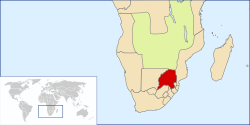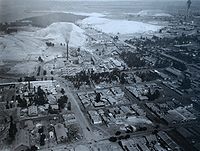Transvaal Colony: Difference between revisions
m WikiCleaner 0.99 - Repairing link to disambiguation page - You can help! |
No edit summary |
||
| Line 72: | Line 72: | ||
|year_deputy1 = 1907 - 1910 |
|year_deputy1 = 1907 - 1910 |
||
|title_deputy = Prime Minister |
|title_deputy = Prime Minister |
||
|today ={{flagcountry|ZAF}} |
|||
| |
| |
||
|footnotes = |
|footnotes = |
||
Revision as of 04:09, 25 May 2010
Colony of the Transvaal | |||||||||||||
|---|---|---|---|---|---|---|---|---|---|---|---|---|---|
| 1877-1881 (Suz.) 1902-1910 | |||||||||||||
Badge of Transvaal Badge | |||||||||||||
 Location of Transvaal, ca. 1890 | |||||||||||||
| Status | British colony | ||||||||||||
| Capital | Pretoria | ||||||||||||
| Common languages | Dutch(written)/Afrikaans(spoken) English Tswana Zulu | ||||||||||||
| Religion | Dutch Reformed, Anglican | ||||||||||||
| Government | Constitutional monarchy | ||||||||||||
| King | |||||||||||||
• 1902-1910 | Edward VII | ||||||||||||
• 1910 | George V | ||||||||||||
| Governor | |||||||||||||
• 1902-1905 | Viscount Milner | ||||||||||||
• 1905-1907 | Earl of Selborne | ||||||||||||
• 1907-1910 | Hamilton John Goold-Adams | ||||||||||||
| Prime Minister | |||||||||||||
• 1907 - 1910 | Louis Botha | ||||||||||||
| Historical era | Scramble for Africa | ||||||||||||
• Established | May 31 1902 | ||||||||||||
| 1877 | |||||||||||||
| 1881 | |||||||||||||
| 1902 | |||||||||||||
• Responsible Govenment | 1907 | ||||||||||||
• Disestablished | May 31 1910 | ||||||||||||
| May 31, 1910 | |||||||||||||
| |||||||||||||
| Today part of | |||||||||||||

The Transvaal (Afrikaans, lit. beyond the Vaal River) is the name of an area of northern South Africa. Originally the bulk of the independent Boer South African Republic, which had existed since 1856, despite two previous attempts by the British of varying success to establish supremacy; after the Anglo-Boer War of 1899-1902 it became the Transvaal Colony, and eventually one of the founding provinces of the Union of South Africa.
History
The Transvaal was colonised by Boer settlers who left the British-dominated Cape Colony in the 1830s and 1840s in what came to be known as the Great Trek. The emigrating Boers established several republics to the north, outside British control - after the British occupation of the former Dutch colony in 1795 and again in 1806. The Great Trek was spurred on by discontent with British rule, the economic upheavals caused by anti slavery laws, lack of protection against raiding Xhosa bands, and Anglicisation of established Dutch traditions. Many autonomous groups, each with its own goals, set out. Some, moving north-east, 'behind' the Nguni societies (Xhosa and Zulu), established the first independent republic, Natalia. This was soon occupied by the British in 1843 via their outpost, Port Natal, on the coast. Two years later the voortrekkers established Transoranje, (1845, later the Orange Free State). Finally, the voortrekkers migrated further north and established a number of smaller republics across the Vaal river, Transvaal, later to be united in the Zuid Afrikaanse Republiek (South African Republic), or ZAR.
The trekkers took advantage of the political vacuum left after the Zulu wars and their aftermath, and easily overcame the indigenous peoples. In the 1850s, the British came to an understanding with the Boer republics, recognising independence to the ZAR in what is now the Transvaal. However, in 1877 Britain annexed the ZAR as a convenient way of resolving the border dispute between the Boers and the Zulus. This also saved the Transvaal from financial ruin, as the government had completely run out of money. The Boer republic regained its independence in 1881[1] after the so-called First Boer War.
Beginning in 1885, the discovery of a tremendous lode of gold in the Witwatersrand led to the immigration of many foreigners (uitlanders) to the Transvaal. In short time the economy of the Transvaal boomed. The wealth of the Transvaal state was bound to overcome the British controlled, Boer dominated Cape Colony, and it was speculated the Boers might eject the British from power in the region[citation needed]. Furthermore, the longer this new source of gold remained out of British control, the position of London as the centre of the world's gold trade was threatened. In these days of the international gold standard, this meant London's position as the world's financial centre in jeopardy, as well as its role as a listening station for Empire intelligence[citation needed]. Using the ZAR refusal to grant Uitlander franchise as a pretext, the British therefore planned a takeover of Transvaal, as a parallel to their seizure years prior of the former Orange Free State and the immense diamond fields of Kimberley therein. In 1895 foreign mine owners funded an attempted coup d'état known as The Jameson Raid. The financiers of the Raid were dissatisfied with the Boer's taxation and restrictions on business. The raid was an awakening for the Boers and led to massive armament, mainly from German suppliers.
Increasing fear of British designs on the Transvaal and the amassing of British forces on their borders led the Boers to make a preemptive strike in 1899. The Second Boer War lasted for three years. By the end of 1902 Britain employed 500,000 soldiers against a fighting force of approximately 64,000 Boers. Boer women and children were incarcerated in concentration camps and about 26,000 died of malnutrition, poor hygiene and disease. This demoralising blow, coupled with the British use of torched earth strategy and a blockade enforced through the entire Transvaal forced the Boer military leaders into submission. A defeated Transvaal was incorporated into the British Empire in 1902. The war also had immense effects on British policy domestically, within Europe and throughout the Empire. The Second Boer War made clear that the Empire was more vulnerable than assumed, and was, in many senses, a rehearsal for greater events that would come to pass twelve years later, in 1914.
In 1910, the Boer republics joined with the Cape Colony to form the Union of South Africa. Half a century later, in 1961, the union ceased to be part of the Commonwealth of Nations and became the Republic of South Africa. The PWV (Pretoria-Witwatersrand-Vereeniging) area in the Transvaal became South Africa's economic powerhouse, a position it still holds today[citation needed].
In 1994, after the fall of apartheid, the former provinces were restructured, and a cohesive Transvaal ceased to exist. The new Gauteng, Limpopo and Mpumalanga provinces lie fully within the borders of the old Transvaal as does most of the North West and also a tiny segment of KwaZulu-Natal. However, even before 1994 the Transvaal province was subdivided into regions for a number of purposes (such as for sporting divisions), into Northern Transvaal (Pretoria, and Limpopo province now), Eastern Transvaal (Mpumalanga province now), Western Transvaal (Northwest province now) and Southern Transvaal (Gauteng province now, excluding Pretoria)
The Transvaal was used as the name of a provincial division of the High Court of South Africa, until 28 February 2009[2]. The division still exists, but under a new name.
Geography
The Transvaal province lay between Vaal River in the south, and the Limpopo River in the north, roughly between 22 1/2 and 27 1/2 S, and 25 and 32 E. To its south it bordered with the Orange Free State and Natal provinces, to its west were the Cape Province and the Bechuanaland Protectorate (later Botswana), to its north Rhodesia (later Zimbabwe), and to its east Portuguese East Africa (later Mozambique) and Swaziland. Except on the south-west, these borders were mostly well defined by natural features.
Several Bantustans were entirely inside the Transvaal: Venda, KwaNdebele, Gazankulu, KaNgwane and Lebowa. Parts of Bophuthatswana were also in the Transvaal, with other parts in Cape Province and Orange Free State.
Within the Transvaal lies the Waterberg Massif, a prominent ancient geological feature of the South African landscape.
Divisions:
Cities in the Transvaal:
In popular culture
Frank Tashlin's 1938 Warner Bros. cartoon You're an Education shows travel brochures coming to life and putting on a musical performance. Among these, the Thief of Baghdad steals some diamonds from Transvaal.
See also
References
- This article incorporates text from a publication now in the public domain: Chisholm, Hugh, ed. (1911). Encyclopædia Britannica (11th ed.). Cambridge University Press.
{{cite encyclopedia}}: Missing or empty|title=(help)
- ^ Stephen J. Lee, Gladstone and Disraeli. Routledge, 108
- ^ De Bruin, P: "Howe se nuwe name van krag", Beeld, 8 March 2009,

